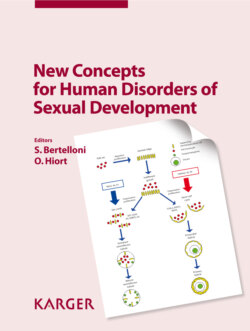Читать книгу New Concepts for Human Disorders of Sexual Development - Группа авторов - Страница 26
На сайте Литреса книга снята с продажи.
Sertoli Cells
ОглавлениеSertoli cells are crucial for testicular histogenesis and future function. In the adult testis, the Sertoli cells are nurse cells for spermatogenesis, creating niches for differentiation of spermatogonial stem cells and providing structural support, nutrients and growth factors for the developing germ cells. Due to the fact that the sperm output in the adult testis is related to the number of Sertoli cells, the control of Sertoli cell proliferation in the developing testis is crucial for future production of male germ cells [Petersen and Söder, 2006]. Pituitary follicle stimulating hormone (FSH) and its receptor (FSHR) are important factors for Sertoli cells development. Functional impairments of the FSHR result in reduced fertility, a reduction of Sertoli cell numbers and, therefore, a reduction of testicular size combined with a reduction in circulating testosterone levels [Huhtaniemi et al., 1987; Simoni et al., 1997; Krishnamurthy et al., 2001; O'Shaughnessy et al., 2007a; online suppl. table 1]. Nevertheless, during the first phase of Sertoli cell differentiation and proliferation, the fetal hypothalamic-pituitary-gonadal (HPG) axis is not yet operative and FSH is not available [Söder, 2007]. Therefore, other growth factors are considered to control the early phase of Sertoli cell proliferation [Petersen et al., 2001, 2002; Petersen and Söder, 2006]. Sertoli cell differentiation and proliferation are important first steps of male sex determination and are controlled by several genes (for details see online suppl. table 1). Therefore, they are exposed targets for disruptive actions of endogenous factors and xenobiotics such as inflammatory mediators and endocrine disrupting compounds (EDCs) [Petersen et al., 2002, 2004; Petersen and Söder, 2006; Söder, 2007].
Pre-Sertoli cells are first defined as cells of the supporting lineage expressing the sex determining region on the Y (SRY) chromosome. After SRY expression, the SRY related HMG box 9 (SOX9), a gene with predominantly testis promoting activity, is expressed by Sertoli cells and leads to an upregulation of AHM, fibroblast growth factor 9 (FGF9) and prostaglandin D2 (PGD2) (for details see online suppl. table 1). These genes are affecting the differentiation of the reproductive tract and therefore defining male sex determination. This process is rapidly followed by morphological changes in the primitive gonad thus adopting testicular features such as formation of testicular cords.
